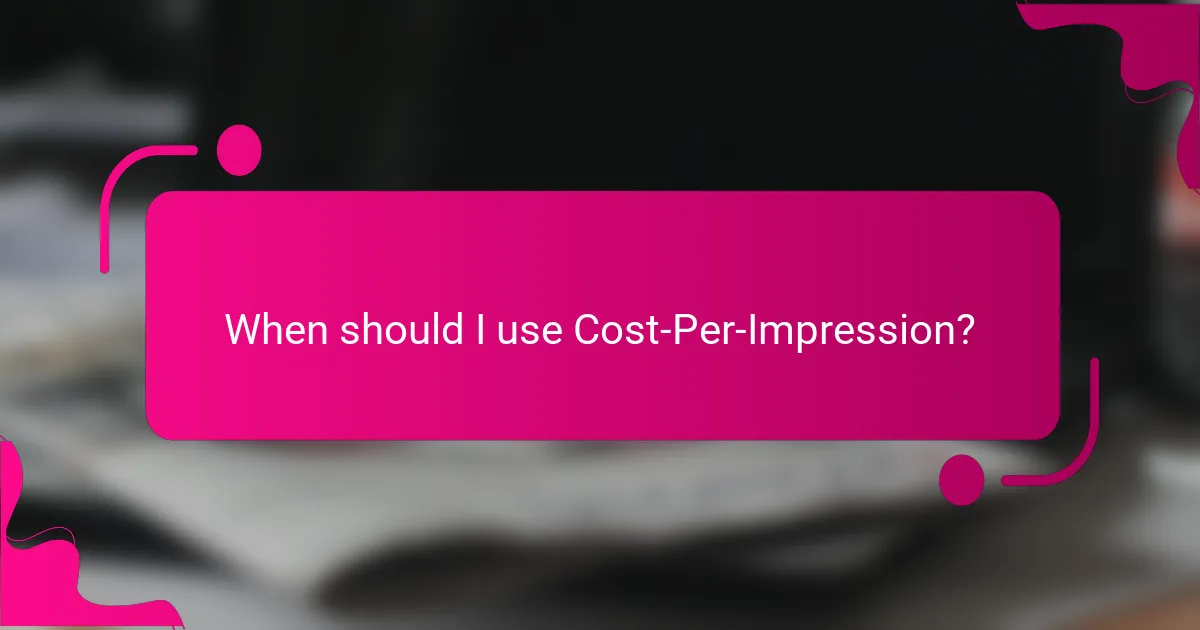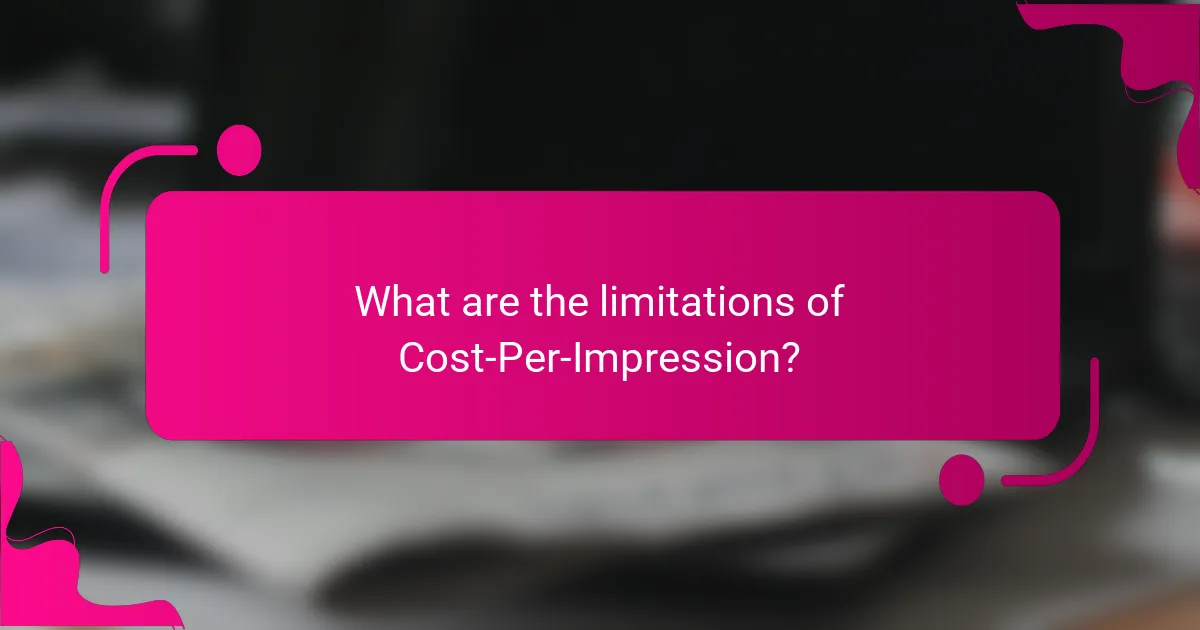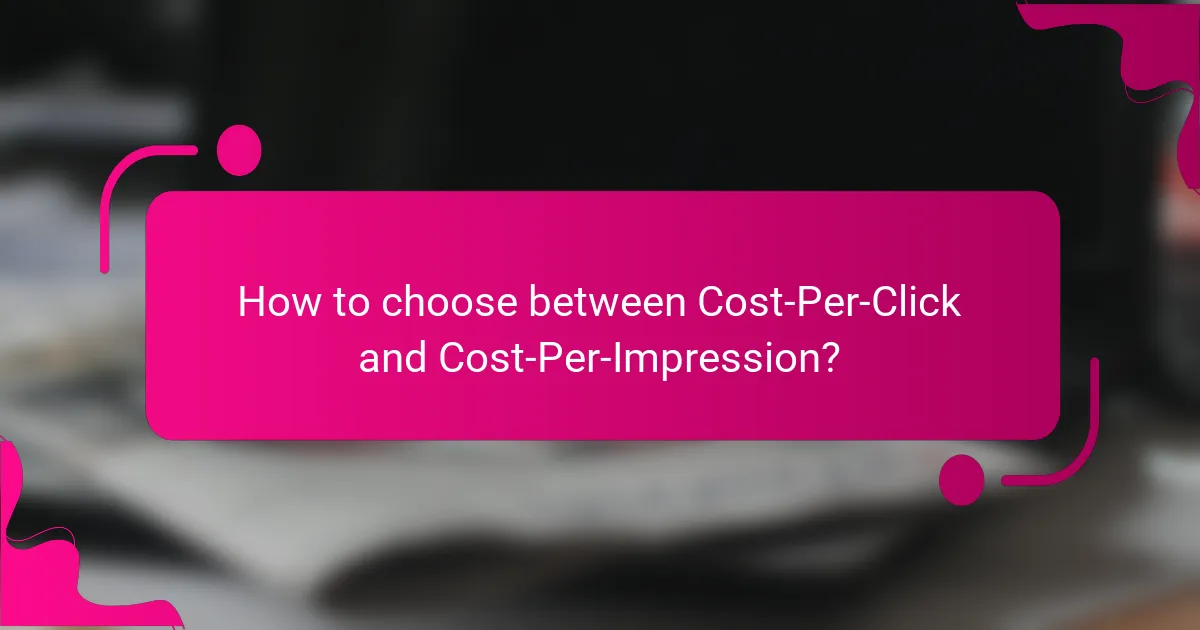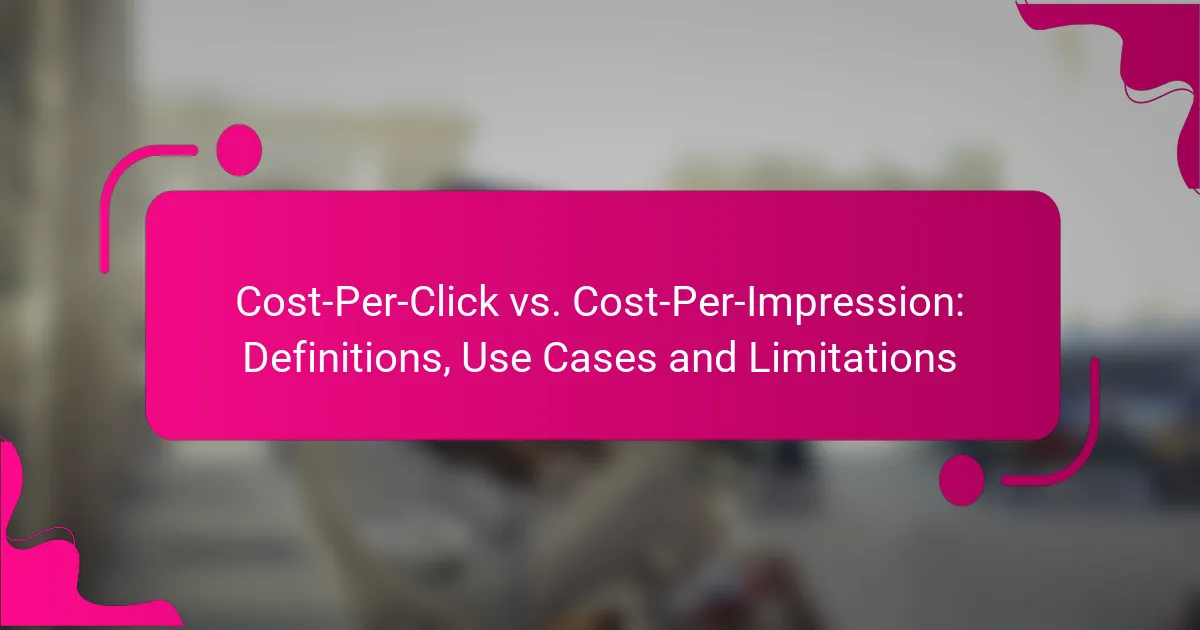Cost-Per-Click (CPC) and Cost-Per-Impression (CPM) are two fundamental advertising payment models that influence budget allocation and campaign strategy. CPC is designed for advertisers aiming to drive traffic by charging only for actual clicks, while CPM focuses on brand visibility by charging based on ad impressions, regardless of user interaction. Understanding the strengths and limitations of each model is crucial for optimizing advertising efforts and achieving specific marketing goals.

What are the key differences between Cost-Per-Click and Cost-Per-Impression?
Cost-Per-Click (CPC) and Cost-Per-Impression (CPM) are two distinct advertising payment models that significantly impact how advertisers allocate their budgets. CPC charges advertisers for each click on their ads, while CPM charges based on the number of times an ad is displayed, regardless of user interaction.
Definition of Cost-Per-Click
Cost-Per-Click (CPC) is a digital advertising model where advertisers pay a fee each time a user clicks on their ad. This model is commonly used in search engine marketing and social media platforms, allowing advertisers to directly measure the effectiveness of their campaigns based on user engagement.
For example, if an advertiser sets a CPC bid of $1 and receives 100 clicks, they will pay $100. This model incentivizes advertisers to create compelling ads that drive user interaction.
Definition of Cost-Per-Impression
Cost-Per-Impression (CPM) is an advertising model where advertisers pay for every 1,000 impressions (views) of their ad, regardless of whether users click on it. This model is often used in display advertising, where brand visibility is prioritized over direct engagement.
For instance, if an advertiser pays a CPM rate of $5 and their ad is shown 10,000 times, they will incur a cost of $50. This approach is beneficial for building brand awareness and reaching a larger audience.
Comparison of payment models
When comparing CPC and CPM, it’s essential to consider the goals of the advertising campaign. CPC is more suitable for campaigns focused on driving traffic and conversions, while CPM is ideal for brand awareness and visibility.
In terms of cost efficiency, CPC can be more economical if the ad generates a high click-through rate, while CPM may offer better value for campaigns targeting a broad audience. Advertisers should analyze their objectives and choose the model that aligns with their strategy.
Impact on advertising strategy
The choice between CPC and CPM can significantly influence an advertising strategy. CPC encourages advertisers to optimize their ads for clicks and conversions, often leading to more targeted campaigns. Advertisers may invest in keyword research and ad copy optimization to improve performance.
On the other hand, CPM focuses on maximizing impressions, which may lead to broader audience targeting and brand recognition. Advertisers should assess their specific goals, whether it’s driving sales or increasing brand visibility, to determine the most effective payment model for their needs.

When should I use Cost-Per-Click?
Cost-Per-Click (CPC) is ideal when your goal is to drive traffic to your website and you want to pay only when users click on your ads. This model is particularly effective for campaigns focused on conversions, as it allows you to directly measure the return on investment for your advertising spend.
Best use cases for Cost-Per-Click
CPC is best suited for businesses aiming to increase website visits, generate leads, or boost sales. It works well for targeted campaigns where the audience is clearly defined, allowing advertisers to optimize their spending based on performance metrics.
For instance, e-commerce platforms often utilize CPC to promote specific products, ensuring they only pay when potential customers show interest by clicking. Additionally, lead generation campaigns can benefit from CPC by attracting users who are more likely to fill out forms or request more information.
Industries benefiting from Cost-Per-Click
Several industries see significant advantages from using CPC. E-commerce, for example, thrives on this model, as it directly correlates ad spending with sales conversions. Retailers can track which ads lead to purchases, allowing for better budget allocation.
Other sectors, such as travel and real estate, also leverage CPC to attract potential clients. These industries often have high-value transactions, making it crucial to target the right audience effectively. By using CPC, they can maximize their advertising efficiency and improve overall campaign performance.

When should I use Cost-Per-Impression?
Cost-Per-Impression (CPI) is ideal when brand visibility is the primary goal, rather than immediate clicks or conversions. This model allows advertisers to pay for every 1,000 impressions, making it suitable for campaigns focused on awareness and reach.
Best use cases for Cost-Per-Impression
CPI is best utilized in campaigns where the objective is to build brand awareness or promote new products. For instance, a company launching a new beverage might use CPI to ensure that its ads are seen by a large audience, even if not everyone clicks on them.
Another effective use case is for retargeting ads, where the goal is to keep the brand top-of-mind for users who have previously interacted with the brand. This approach can help reinforce brand recognition and recall.
Industries benefiting from Cost-Per-Impression
Industries such as consumer goods, fashion, and entertainment often benefit from CPI campaigns, as these sectors rely heavily on visual appeal and brand recognition. For example, a fashion retailer may use CPI to showcase seasonal collections to a broad audience.
Additionally, the technology sector can leverage CPI for product launches or announcements, ensuring that potential customers are aware of new features or innovations. This approach is particularly effective in crowded markets where standing out is crucial.

What are the limitations of Cost-Per-Click?
Cost-Per-Click (CPC) has several limitations that advertisers should consider. While it can drive traffic effectively, it may not always lead to conversions or desired outcomes, making it essential to evaluate its effectiveness in the context of overall marketing goals.
Potential drawbacks of Cost-Per-Click
One significant drawback of CPC is that it can encourage click fraud, where competitors or bots generate false clicks to deplete an advertiser’s budget. This can lead to inflated costs without any real engagement or sales. Additionally, CPC campaigns may attract users who are not genuinely interested in the product, resulting in low conversion rates.
Another limitation is the focus on immediate results. Advertisers may prioritize clicks over long-term brand building, which can undermine overall marketing strategies. This short-term focus can lead to missed opportunities for deeper customer engagement and loyalty.
Common misconceptions about Cost-Per-Click
A common misconception is that a higher CPC always guarantees better results. In reality, a high CPC does not necessarily equate to high-quality traffic or conversions. Advertisers should focus on the relevance and targeting of their ads rather than solely on the cost per click.
Another myth is that CPC is the only metric that matters for online advertising. While it is important, it should be considered alongside other metrics like conversion rates and return on investment (ROI). A comprehensive approach that evaluates multiple performance indicators will yield better insights into campaign effectiveness.

What are the limitations of Cost-Per-Impression?
Cost-Per-Impression (CPI) has several limitations that can affect its effectiveness in advertising campaigns. Primarily, it does not guarantee engagement or conversions, as advertisers pay for visibility rather than actual interactions.
Potential drawbacks of Cost-Per-Impression
One major drawback of Cost-Per-Impression is that it can lead to wasted ad spend if the impressions do not result in clicks or conversions. Advertisers may find themselves paying for views that do not translate into meaningful customer actions. Additionally, CPI can incentivize publishers to prioritize quantity over quality, potentially leading to placements in less relevant or lower-quality environments.
Another limitation is the difficulty in accurately measuring the effectiveness of CPI campaigns. Since the focus is on impressions, it can be challenging to assess the true impact on brand awareness or customer engagement. This lack of direct correlation between impressions and outcomes can complicate performance evaluations.
Common misconceptions about Cost-Per-Impression
A common misconception is that higher impression counts always lead to better brand visibility. While increased impressions can enhance awareness, they do not guarantee that the audience is engaged or interested in the product. Advertisers may mistakenly believe that simply increasing their budget for impressions will automatically improve their campaign’s success.
Another misconception is that Cost-Per-Impression is suitable for all types of advertising goals. In reality, it is most effective for campaigns focused on brand awareness rather than direct response. Advertisers aiming for conversions may find more success with Cost-Per-Click (CPC) models, which align payment with user engagement.

How to choose between Cost-Per-Click and Cost-Per-Impression?
Choosing between Cost-Per-Click (CPC) and Cost-Per-Impression (CPM) depends on your advertising goals and budget. CPC is more suitable for driving traffic and conversions, while CPM is ideal for brand awareness and visibility.
Decision-making criteria
When deciding between CPC and CPM, consider your campaign objectives. If your goal is to generate leads or sales, CPC allows you to pay only when users click on your ad, making it more cost-effective for performance-driven campaigns. Conversely, if you aim to increase brand exposure, CPM can be more beneficial as it charges based on impressions, allowing for broader reach.
Evaluate your target audience and the platforms you are using. For example, platforms like Google Ads often favor CPC for search ads, while social media platforms may offer both options, allowing you to choose based on your specific needs.
Factors influencing choice
Several factors can influence your choice between CPC and CPM. Your budget plays a crucial role; CPC may lead to higher costs per click, especially in competitive markets, while CPM can provide a more predictable cost structure for visibility. Analyze your historical data to determine which method has previously yielded better results for your campaigns.
Additionally, consider the nature of your product or service. If you have a high-value item that requires more consideration before purchase, CPC might be more effective. In contrast, if you are promoting a low-cost item or service, CPM could maximize your reach and brand recognition.
